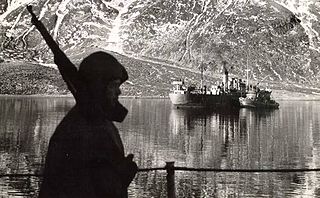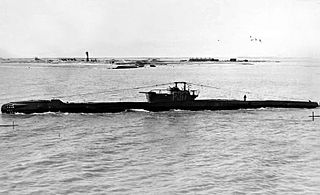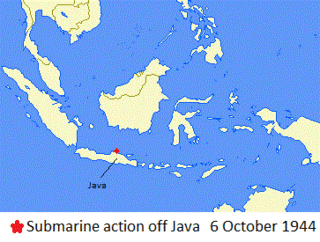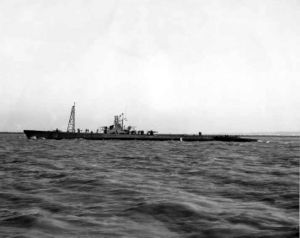
USS Flier (SS-250) was a Gato-class submarine, was the only ship of the United States Navy to be named for the flier.

USS Salmon (SS-182) was the lead ship of her class of submarine. She was the second ship of the United States Navy to be named for the salmon, a soft-finned, game fish which inhabits the coasts of America and Europe in northern latitudes and ascends rivers for the purpose of spawning.

USS Flounder (SS-251), a Gato-class submarine, was the only ship of the United States Navy to be named for the flounder.

German submarine U-537 was a Type IXC/40 U-boat of Nazi Germany's Kriegsmarine during World War II. Her keel was laid down on 10 April 1942 by Deutsche Werft in Hamburg. She was commissioned on 27 January 1943 with Kapitänleutnant Peter Schrewe in command. Schrewe commanded the boat for nearly two years, until her loss.
USS Bergall (SS-320), a Balao-class submarine, was the first ship of the United States Navy to be named for the bergall, a small fish of the New England coast. Her keel was laid down by the Electric Boat Company in Groton, Connecticut. She was later sold to Turkey and operated as TCG Turgutreis until scrapped in April 2000.

Human torpedoes or manned torpedoes are a type of diver propulsion vehicle on which the diver rides, generally in a seated position behind a fairing. They were used as secret naval weapons in World War II. The basic concept is still in use.

USS Flying Fish (SS/AGSS-229), a Gato-class submarine, was the first submarine and second ship of the United States Navy to be named for the flying fish.

USS Hawkbill (SS-366), a Balao-class submarine, was the first ship of the United States Navy to be named for the hawksbill, a large sea turtle.

USS Guitarro (SS-363), a Gato-class submarine, was the first ship of the United States Navy to be named for the guitarro.

USS Paul Jones (DD-230/AG–120) was a Clemson-class destroyer in the United States Navy during World War II. It was the second ship named for John Paul Jones.

USS Niblack (DD-424), a Gleaves-class destroyer, is the only ship of the United States Navy to be named for Albert Parker Niblack. Niblack became the Director of Naval Intelligence 1 March 1919, and Naval Attache in London 6 August 1920. As Vice Admiral, he commanded U.S. Naval Forces in European waters 15 January 1921 to 17 June 1922.

There was considerable Axis naval activity in Australian waters during the Second World War, despite Australia being remote from the main battlefronts. German and Japanese warships and submarines entered Australian waters between 1940 and 1945 and attacked ships, ports and other targets. Among the best-known attacks are the sinking of HMAS Sydney by a German raider in November 1941, the bombing of Darwin by Japanese naval aircraft in February 1942, and the Japanese midget submarine attack on Sydney Harbour in May 1942. About 40 Allied merchant ships were damaged or sunk off the Australian coast by surface raiders, submarines and mines. Japanese submarines also shelled three Australian ports and submarine-based aircraft flew over several Australian capital cities.

The American Theater was a theater of operations during World War II including all continental American territory, and extending 200 miles (320 km) into the ocean.

HMS Seadog was a third-batch S-class submarine built for the Royal Navy during World War II. Completed in September 1942, she spent most of her career in Arctic waters, off Norway, but sank only one German ship in 13 patrols. In January 1945, she was redeployed to the Far East, meeting more success. On her first patrol in the area, the submarine rescued four American airmen. After two patrols, she and her sister ship HMS Shalimar sank five sailing vessels, two coasters, a barge, a tugboat and a Japanese tank landing ship. After the war ended, Seadog was sent back to England, placed in reserve, then sold for scrap in December 1947. She was ultimately broken up in August 1948.

HMS Shalimar was a third-batch S-class submarine built for the Royal Navy during World War II. Completed in April 1944, she conducted one war patrol off the Orkney Islands, then was assigned to the Pacific theater, arriving there in September. The submarine conducted one war patrol off the Nicobar Islands, destroying several small ships with gunfire. During her next three patrols in the Strait of Malacca, Shalimar sank twelve sailing vessels, eleven landing craft, four coasters, three lighters, three tugboats, and one minesweeper. After the war ended, the boat was sent back to England, placed in reserve, then sold for scrap in July 1950.
HMS Porpoise (N14) was one of the six-ship class of Grampus-class mine-laying submarines of the Royal Navy. She was built at Vickers Armstrong, Barrow and launched 30 August 1932. She served in World War II in most of the naval theatres of the war, in home waters, the Mediterranean and the Far East. She was sunk with all hands by Japanese aircraft on 19 January 1945, and was the last Royal Navy submarine to be lost to enemy action.

HNLMS Zwaardvisch (S814) was the lead ship of the Royal Netherlands Navy's Zwaardvisch-class submarine, which was based on the British T class. The submarine was originally ordered as HMS Talent (P322) and built by Vickers Armstrong, Barrow, and John Brown & Company, Clydebank. It served mainly in the Pacific against the Japanese during the war, operating under both British and US operational command in Ceylon and Australia. In 1950, the vessel was renamed HNLMS Zwaardvis. She was sold and broken up for scrap in 1963.

The action of 14 February 1944 refers to the sinking of a German U-boat off the Strait of Malacca during World War II by a British submarine. It was one of the few naval engagements of the Asian and Pacific theater involving German and Italian forces.

The action of 6 October 1944 was an incident of World War II in which a German U-boat was sunk by a Dutch submarine while operating in the Java Sea. The sinking was part of the German U-boat campaign in the Indian and Pacific Oceans.

Submarine warfare in the Black Sea in World War II during 1944 involved engagements between submarines of the Soviet Black Sea Fleet attacking Axis merchantmen, defended by Romanian and German naval warships, as well as German U-boats and Romanian submarines attacking Soviet merchants on the eastern Black Sea. Before the conclusion of the campaign, Romania joined the Allies after King Michael's Coup. These engagements were a part of the naval Black Sea campaigns.


















